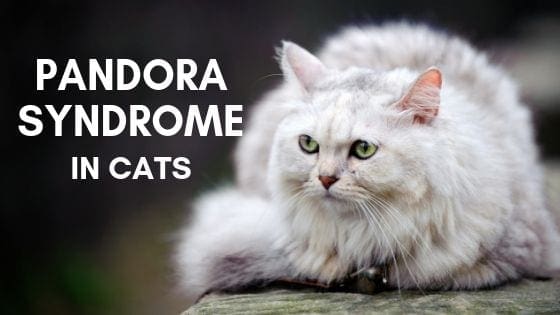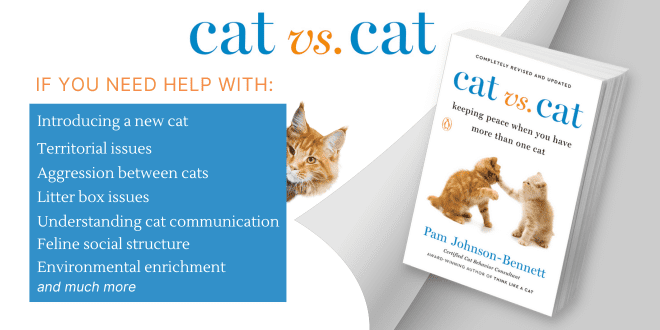
Almost everyone is familiar with the story of Pandora’s box. Zeus had given Pandora a locked box with a key, but she was instructed never to open it. Her curiosity got the better of her and when she unlocked the box, all the evils in the world escaped.
In 2011, a study was done at the Ohio State University, led by Dr. Tony Buffington. The research revealed that when it comes to feline urinary issues, it was more than just being about the bladder. There was a connection between the urinary recurrences and stress. Dr. Buffington coined the term for these urinary issues, Pandora Syndrome, after the Greek myth of Pandora’s box. The research connects the cat’s big enemy, stress, to frequent recurrences of Feline Idiopathic Cystitis.
Feline urinary tract problems are difficult to diagnose and treat. Urinary tract problems used to be labeled under the umbrella term FLUTD (feline lower urinary tract disease) or FIC (feline idiopathic cystitis).
FIC, is labeled so when no identifiable cause can be found for the chronic bladder inflammation. The condition waxes and wanes. The research out of the Ohio State University shows FIC to be one result of many problems of the body triggered by stress.
The cats who are most susceptible are the ones who are more nervous, fearful, and sensitive in general. It is believed these cats have an abnormal stress response system. They startle more easily than other cats and stay hyper alert. As a result of cats remaining in stress alert, systems of the body (immune, gastrointestinal, cardiovascular, and so on) are affected and that sets the cats up for various illnesses. It’s not unusual for cats with Pandora Syndrome to also exhibit other sickness behaviors such as loss of appetite, diarrhea, vomiting, etc.
Diagnosing Pandora Syndrome
Diagnosis of Pandora Syndrome is difficult since there are many causes for the problem. A thorough exam, along with urinalysis and bloodwork are performed. A thorough behavioral history is needed as well. Your cat’s veterinarian needs to know about the home environment, stressful events or any trauma. Did something happen in the cat’s life that was traumatic and as a result, the cat remains in a state of stress, even in the absence of any threat? It’s also important for the veterinarian to know whether the cat was orphaned, if the cat was socialized as a kitten, as well as anything else that will help put the pieces of the puzzle together.
Treatment of Pandora Syndrome
Your cat’s veterinarian will prescribe medication as needed, including pain relief and anti-inflammatory medication. The rest of the treatment involves reducing stress in your cat’s environment. For a cat with Pandora Syndrome, don’t overlook any potential stress triggers. The cure will come from what you can do to lower stress and provide an ongoing sense of security.
Cats with Pandora Syndrome need:
- Safe, personal space
- Safe placement of feeding stations
- Safe places for resting without fear of ambush or threat
- Interactive playtime with you
- Safe opportunities for solo playtime and enrichment activities
- Social contact in the way the cat prefers
- Consistent and predictable schedule
- Provide clean litter boxes in the right locations and in ample numbers
- Access to appealing scratching posts
- Very gradual transitions
- No conflicts with other cats or pets in the home
- Reduced noise in the home
- Choice
- Ability to escape to safe rooms away from noise, visitors, etc.
- Access to vertical locations
- Hiding places
- Time with you
Personal space, safety, stress reduction, and enrichment matter in a cat’s life. If you live in a multicat environment be aware of how the stability of the cat family social structure, the need for territory, and secure resource availability are all essential. If a cat has a litter box issue, in addition to getting the medical diagnosis, it’s time to re-evaluate how any of the items listed above may not be available in a way that meets a cat’s needs.
With a multicat household, the relationship problem may not even be between cats, so keep that in mind as you try to uncover ongoing stress issues. The tension may be between a cat and a human family member. This could be due to the person being new to the family, punishment from someone in the family, or inconsistent interaction. As you examine the relationships between the cats, and evaluate the environment, also carefully review the social relationship between cats and the rest of the family.
Need More Information?
If you have questions about Pandora Syndrome and any other aspect of your cat’s health or behavior, make an appointment with your veterinarian. This article is not intended to diagnose nor is it a replacement for your cat’s regular veterinary care.
For more information about cat behavior and training, refer to the books by Pam Johnson-Bennett. Pam’s books are available at bookstores and online. We’ve included Amazon links here on our website.
 Problem Solving & Advice by Pam Johnson-Bennett Cat Behavior Expert & Best-selling Author
Problem Solving & Advice by Pam Johnson-Bennett Cat Behavior Expert & Best-selling Author



